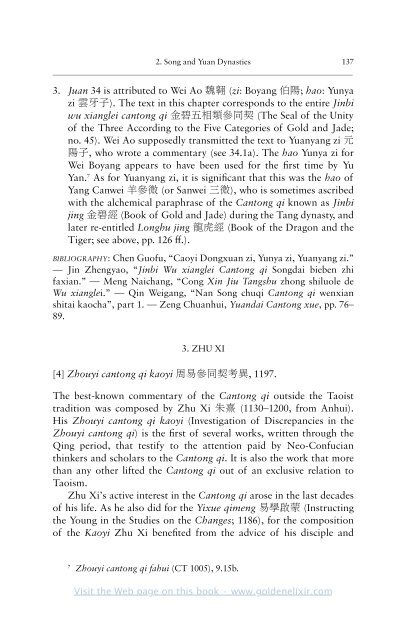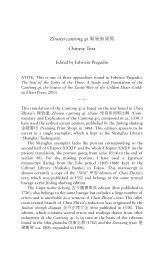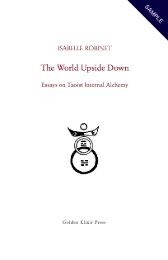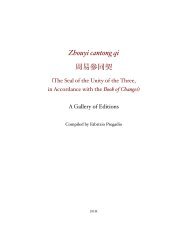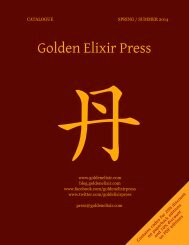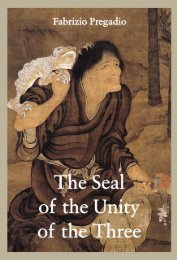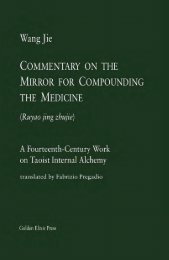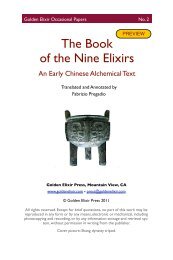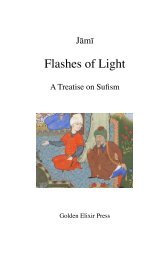The Seal of the Unity of the Three â Vol. 2 - The Golden Elixir
The Seal of the Unity of the Three â Vol. 2 - The Golden Elixir
The Seal of the Unity of the Three â Vol. 2 - The Golden Elixir
- No tags were found...
You also want an ePaper? Increase the reach of your titles
YUMPU automatically turns print PDFs into web optimized ePapers that Google loves.
2. Song and Yuan Dynasties 137<br />
—————————————————————————————————————————<br />
3. Juan 34 is attributed to Wei Ao 魏 翱 (zi: Boyang 伯 陽 ; hao: Yunya<br />
zi 雲 牙 子 ). <strong>The</strong> text in this chapter corresponds to <strong>the</strong> entire Jinbi<br />
wu xianglei cantong qi 金 碧 五 相 類 參 同 契 (<strong>The</strong> <strong>Seal</strong> <strong>of</strong> <strong>the</strong> <strong>Unity</strong><br />
<strong>of</strong> <strong>the</strong> <strong>Three</strong> According to <strong>the</strong> Five Categories <strong>of</strong> Gold and Jade;<br />
no. 45). Wei Ao supposedly transmitted <strong>the</strong> text to Yuanyang zi 元<br />
陽 子 , who wrote a commentary (see 34.1a). <strong>The</strong> hao Yunya zi for<br />
Wei Boyang appears to have been used for <strong>the</strong> first time by Yu<br />
Yan. 7 As for Yuanyang zi, it is significant that this was <strong>the</strong> hao <strong>of</strong><br />
Yang Canwei 羊 參 微 (or Sanwei 三 微 ), who is sometimes ascribed<br />
with <strong>the</strong> alchemical paraphrase <strong>of</strong> <strong>the</strong> Cantong qi known as Jinbi<br />
jing 金 碧 經 (Book <strong>of</strong> Gold and Jade) during <strong>the</strong> Tang dynasty, and<br />
later re-entitled Longhu jing 龍 虎 經 (Book <strong>of</strong> <strong>the</strong> Dragon and <strong>the</strong><br />
Tiger; see above, pp. 126 ff.).<br />
BIBLIOGRAPHY: Chen Gu<strong>of</strong>u, “Caoyi Dongxuan zi, Yunya zi, Yuanyang zi.”<br />
— Jin Zhengyao, “Jinbi Wu xianglei Cantong qi Songdai bieben zhi<br />
faxian.” — Meng Naichang, “Cong Xin Jiu Tangshu zhong shiluole de<br />
Wu xianglei.” — Qin Weigang, “Nan Song chuqi Cantong qi wenxian<br />
shitai kaocha”, part 1. — Zeng Chuanhui, Yuandai Cantong xue, pp. 76–<br />
89.<br />
3. ZHU XI<br />
[4] Zhouyi cantong qi kaoyi 周 易 參 同 契 考 異 , 1197.<br />
<strong>The</strong> best-known commentary <strong>of</strong> <strong>the</strong> Cantong qi outside <strong>the</strong> Taoist<br />
tradition was composed by Zhu Xi 朱 熹 (1130–1200, from Anhui).<br />
His Zhouyi cantong qi kaoyi (Investigation <strong>of</strong> Discrepancies in <strong>the</strong><br />
Zhouyi cantong qi) is <strong>the</strong> first <strong>of</strong> several works, written through <strong>the</strong><br />
Qing period, that testify to <strong>the</strong> attention paid by Neo-Confucian<br />
thinkers and scholars to <strong>the</strong> Cantong qi. It is also <strong>the</strong> work that more<br />
than any o<strong>the</strong>r lifted <strong>the</strong> Cantong qi out <strong>of</strong> an exclusive relation to<br />
Taoism.<br />
Zhu Xi’s active interest in <strong>the</strong> Cantong qi arose in <strong>the</strong> last decades<br />
<strong>of</strong> his life. As he also did for <strong>the</strong> Yixue qimeng 易 學 啟 蒙 (Instructing<br />
<strong>the</strong> Young in <strong>the</strong> Studies on <strong>the</strong> Changes; 1186), for <strong>the</strong> composition<br />
<strong>of</strong> <strong>the</strong> Kaoyi Zhu Xi benefited from <strong>the</strong> advice <strong>of</strong> his disciple and<br />
7<br />
Zhouyi cantong qi fahui (CT 1005), 9.15b.<br />
Visit <strong>the</strong> Web page on this book • www.goldenelixir.com


